Ranking of the best medical voicebots in Poland – 2025
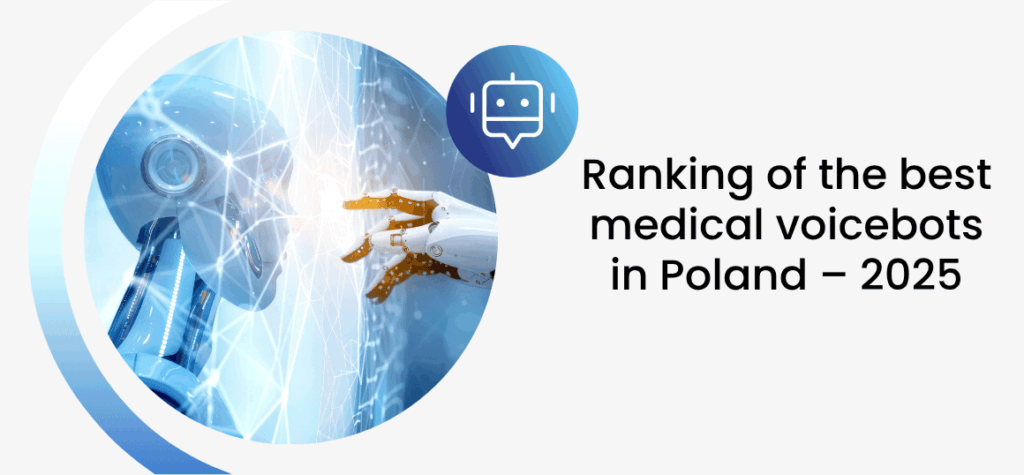
Ranking of the best medical voicebots in Poland – 2025
A medical voicebot is a tool that allows the automation of selected areas of a medical facility’s operations and the optimization of related costs. No wonder it is increasingly used by both private clinics and public healthcare facilities. But how do you choose a solution that perfectly matches your facility’s needs? Here’s our subjective ranking of the TOP 10 medical voicebots in Poland in 2025.
What is a medical voicebot?
A medical voicebot is an intelligent AI-based tool designed to conduct real-time voice conversations. Solutions dedicated to the healthcare sector can handle patient registration, verify patient data, and answer their questions. This way, they reduce the workload of medical reception staff and minimize the need for additional hires. At the same time, they are efficient and capable of handling multiple inquiries simultaneously. When integrated with specialists’ calendars, they also help reduce the risk of overlapping appointments. Such a voice assistant significantly streamlines daily operations and improves patient satisfaction — all while reducing the operating costs of a medical facility.
What to consider when choosing a medical voicebot?
Selecting a medical voicebot should be preceded by thorough analysis. This involves reviewing the tool’s functionalities, performance parameters, accuracy in speech recognition and language understanding, as well as the post-sales support offered by the provider. The pricing model is also an important factor.
When creating this ranking, we examined these tools in detail to identify their strengths and weaknesses. We also analyzed user reviews and assessed how well they meet the requirements of the Polish healthcare sector. The criteria we considered included, among others:
- speech recognition module (ASR),
- natural language understanding module (NLU),
- accuracy in conducting conversations and recognizing intent in Polish,
- technical support provided by the supplier,
- compliance with Polish law, including GDPR regulations,
- potential for integration with medical systems,
- customization of conversation scripts,
- machine learning capabilities,
- pricing model,
- and more.
Based on this analysis, we selected 10 tools that we believe are worth attention. These are medical voicebots tailored to the needs of modern patients and the challenges faced by medical facility managers. We encourage you to explore our ranking — it can serve as an excellent starting point in selecting a solution suited to your needs.
Our TOP 10 medical voicebots in Poland in 2025
With medical facility managers in mind, we have prepared our ranking of what we believe to be the best medical voicebots available on the Polish market in 2025. We have dedicated a short description to each tool. If you would like to learn more, we encourage you to explore the details on the tool’s website or contact the selected company’s representative directly. Below is our Top 10 list.
1. EasyCall
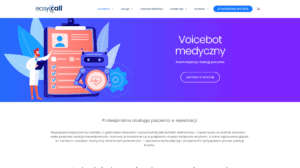 One of the market leaders in providing intelligent tools for the medical sector. It performs exceptionally well in automated patient registration and appointment scheduling. It can conduct a basic medical interview and answer a wide range of frequently asked patient questions. Additionally, EasyCall’s specialists provide comprehensive support during both implementation and ongoing operation, along with a favorable pricing model. What else makes the EasyCall medical voicebot stand out? Certainly the fact that it is already widely used by many clinics in Poland.
One of the market leaders in providing intelligent tools for the medical sector. It performs exceptionally well in automated patient registration and appointment scheduling. It can conduct a basic medical interview and answer a wide range of frequently asked patient questions. Additionally, EasyCall’s specialists provide comprehensive support during both implementation and ongoing operation, along with a favorable pricing model. What else makes the EasyCall medical voicebot stand out? Certainly the fact that it is already widely used by many clinics in Poland.
Advantages:
- high efficiency in handling patient registration,
- advanced analytics and reporting,
- excellent understanding of the Polish language,
- potential for integration with medical systems and other tools,
- simple creation of conversation scenarios and strategy implementation,
- easy to scale and flexible to operate.
Disadvantages:
- language limitations for foreign patients,
- requires specialized implementation,
- difficulty handling more complex inquiries,
- high costs for small entities.
2. Asseco
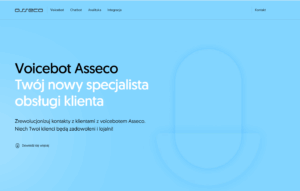
Second place in our ranking goes to the medical voicebot from a domestic giant — Asseco. The Asseco Medical Voicebot is a highly developed tool used by many clinics across Poland. It is characterized by intuitive operation and high efficiency in patient registration and appointment cancellations. The tool can conduct advanced real-time conversations.
Advantages:
- multilingual support, including service for foreign patients,
- ability to handle advanced conversation scenarios,
- cloud-based model enabling easy scalability.
Disadvantages:
- complex and difficult configuration process,
- high implementation costs,
- limitations in responding to non-standard queries.
3. Apifonica

The Apifonica Medical Voicebot is dedicated to the medical sector. As a global player, Apifonica provides technology solutions to many industries. Its medical voicebot can handle up to 150 languages, although not all are equally advanced. The tool enables 24/7 patient communication, helps automate the registration process, and improves the quality of telephone service. It includes many useful features, such as satisfaction surveys and appointment reminders.
Advantages:
- highly natural-sounding conversations,
- multilingual support (up to 150 languages),
- a reputable provider with an established market position.
Disadvantages:
- complex implementation process that takes several weeks,
- high initial investment costs,
- limitations in understanding unusual queries and issues.
4. Sovva
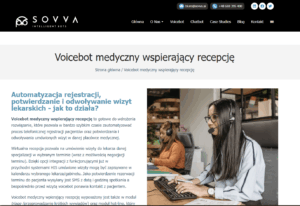
Just off the podium in our ranking is the medical voicebot from Sovva S.A. This is a comprehensive tool designed to support processes related to patient registration in medical facilities. It also assists in appointment management (e.g., cancellations). Noteworthy are the voicebot’s ease of use and the clarity of the data it presents — a feature that will appeal to less tech-savvy users. An interesting function is the medical hotline, which allows for automatic call redirection to emergency services or a paramedic in critical situations.
Advantages:
- flexible tool with easy implementation,
- ability to personalize patient service,
- advanced NLP technology.
Disadvantages:
- time needed to fine-tune conversation scenarios,
- low empathy toward patients,
- additional costs for using advanced features.
5. Ironteam
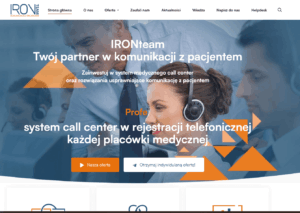
The Ironteam medical voicebot is a tool specifically designed for the medical sector and intended for telephone patient registration. It acts as a voice assistant, guiding patients through the process of registering with a doctor, canceling appointments, or answering basic questions. In addition, Ironteam offers the GATEway call center system. This tool is well adapted to the Polish market.
Advantages:
- low patient service costs,
- wide range of functionalities,
- comprehensive technical support from Ironteam specialists.
Disadvantages:
- limited understanding of advanced questions,
- complex and time-consuming configuration and implementation,
- lower market recognition, which affects trust in the tool.
6. Welyo
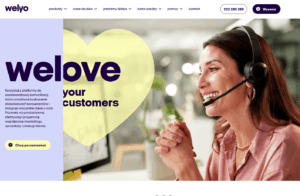
The Welyo medical voicebot is dedicated to healthcare facilities and effectively supports the contact center area. It can successfully take over a significant portion of communication related to patient registration and responding to FAQs. Many clinics already use it daily, but it is still building its market position and, for now, struggles to compete with the bigger players.
Advantages:
- extensive features, including automatic appointment reminders,
- easy integration with specialist calendars,
- personalized communication with patients.
Disadvantages:
- complex configuration and integration with external tools,
- underdeveloped NLP module,
- potential errors during the registration process.
7. Debesis
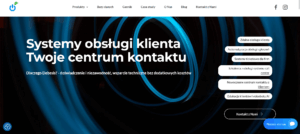
A less recognizable tool on the Polish market. Nevertheless, the Debesis medical voicebot has its strengths and is worth considering for implementation in a medical facility. It facilitates the automation of many processes, helping reduce the costs of running a clinic. On the other hand, the tool is still in the development phase and seems to lag technologically behind those ranked higher in our list. Its overall usability also leaves something to be desired.
Advantages:
- full support for the Polish language,
- effective in automating communication,
- ability to integrate with external systems and databases.
Disadvantages:
- requires additional configuration and adaptation to the medical sector,
- high initial implementation cost,
- limitations in understanding the context of speech.
8. HIX AI

The HIX AI tool is not very popular in the Polish market. Its voicebot modules are still under development, and at this stage, implementing them in the medical sector is challenging. It is much easier to do so in the case of text-based bots that handle patient messages on websites or social media. However, the tool is promoted as a solution for medical facilities, which is why it made it into our ranking. For now, though, there are many better options available.
Advantages:
- low operating costs,
- ability to personalize communication.
Disadvantages:
- poor understanding of the Polish language,
- difficulties in implementing advanced scenarios,
- technological limitations of the tool.
9. XO Media
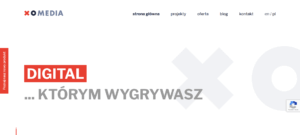
The xoVOICE medical voicebot is developed by XO Media and is well adapted to the realities of the Polish market. This virtual assistant clearly supports clinic operations as well as the daily work of receptionists and consultants. It is commonly used for patient registration, FAQ handling, data verification, and conducting basic medical interviews.
Advantages:
- high integration potential with other tools, including CRM/HIS,
- patient segmentation,
- support for telemedicine services,
- multilingual capability.
Disadvantages:
- requires advanced configuration and time-consuming testing,
- high costs when using advanced functions,
- lack of flexible adaptation of responses to the conversation scenario.
10. Daktela
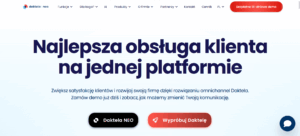
Closing our ranking is the Daktela voicebot, which is also used in the medical sector. However, this requires more work, as the tool is currently universal in nature. It is up to the client to adapt it to a specific sector and its needs. With the help of a professional, it is possible to create a functional tool that supports the daily work of medical receptionists — though this may involve additional costs.
Advantages:
- intuitive tool operation,
- support offered by Daktela’s technical team,
- simple integration with external tools.
Disadvantages:
- need to adapt conversation scenarios to the medical sector,
- potentially higher implementation costs,
- difficulty understanding medical topics.
A voicebot is a good choice, but it won’t solve every problem
Now you know what defines medical voicebots and which tools in this category rank among the best on the Polish market. A carefully selected, properly implemented, and well-managed voicebot can bring many benefits. However, it is important to remember that it will not solve every problem. At present, such tools are not capable of handling 100% of all conversations. Moreover, some patients still prefer in-person contact at a medical facility or to speak directly with a human. For this reason, voicebots should be treated as valuable support, and their use should complement human work in the facility. Choose the voicebot that perfectly matches your needs, using our ranking as your guide.
